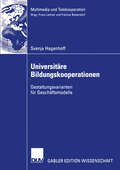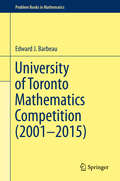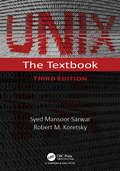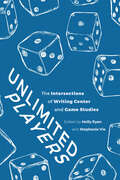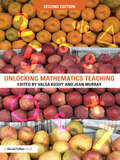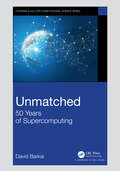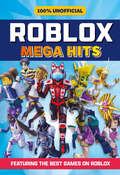- Table View
- List View
Universitäre Bildungskooperationen: Gestaltungsvarianten für Geschäftsmodelle (Multimedia und Telekooperation)
by Svenja HagenhoffSvenja Hagenhoff untersucht die management- und organisationsbezogenen Zusammenhänge von Hochschulkooperationen und erstellt Markt-, Leistungs- und Ressourcenanalysen, um Kooperationspotenziale im Bereich der Lehre zu erschließen. Die inneren Zusammenhänge der Kooperation werden sowohl auf operativer als auch auf strategischer Ebene analysiert.
University Education in Computing Science: Proceedings of a Conference on Graduate Academic and Related Research Programs in Computing Science, Held at the State University of New York at Stony Brook, June 1967
by Aaron FinermanUniversity Education in Computing Science documents the proceedings of a conference on graduate academic and related research programs in computing science, held at the State University of New York at Stony Brook on June 8, 1967. This book provides a comprehensive study of the role of the computing sciences as an academic program, including its organizational structure and relationship to the computing center. The undergraduate education in computing science and operational policies of university computing centers are also elaborated. Other topics include the graduate computer science program at American universities, dilemma of computer sciences, and science and engineering of information. The industry's view of computing science and doctoral program in computing science are likewise covered. This publication is suitable for educational, industrial, and governmental organizations concerned with education related to computing science.
University of Toronto Mathematics Competition (Problem Books in Mathematics #0)
by Edward J. BarbeauThis text records the problems given for the first 15 annual undergraduate mathematics competitions, held in March each year since 2001 at the University of Toronto. Problems cover areas of single-variable differential and integral calculus, linear algebra, advanced algebra, analytic geometry, combinatorics, basic group theory, and number theory. The problems of the competitions are given in chronological order as presented to the students. The solutions appear in subsequent chapters according to subject matter. Appendices recall some background material and list the names of students who did well. The University of Toronto Undergraduate Competition was founded to provide additional competition experience for undergraduates preparing for the Putnam competition, and is particularly useful for the freshman or sophomore undergraduate. Lecturers, instructors, and coaches for mathematics competitions will find this presentation useful. Many of the problems are of intermediate difficulty and relate to the first two years of the undergraduate curriculum. The problems presented may be particularly useful for regular class assignments. Moreover, this text contains problems that lie outside the regular syllabus and may interest students who are eager to learn beyond the classroom.
University Performance Before and During Economic Crises: An Analysis of Graduate Characteristics (UNIPA Springer Series)
by Rosalinda Allegro Ornella GiambalvoThis book briefly analyzes the performance of selected Italian universities during a pre-crisis period and an economic crisis period, on the basis of graduate characteristics and graduate placement statistics. The Electre model is used to produce eighteen university rankings according to three different scenarios (Neutral, University, and Job), three different roles ascribed to the key criteria (overeducation and mismatching), and two years corresponding to two postgraduation placement sampling surveys carried out in a pre-crisis period (2006) and during a crisis period (2011). The eighteen rankings are based on Economics/Statistics and Political & Social Sciences graduates. The rankings vary according to both the scenarios considered and graduate characteristics. Some differences are noted between the two fields of study. The book will be of interest for statisticians interested in evaluation issues, policymakers concerned with university comparisons and rankings, and future students and graduates wishing to make the best choice when selecting their university course. In addition, the new methodology adopted will be relevant for scholars in Statistics and Engineering.
University Research and Regional Innovation: A Spatial Econometric Analysis of Academic Technology Transfers (Economics of Science, Technology and Innovation #13)
by Attila Varga4 UNIVERSITY RESEARCH AND THE SPATIAL DISTRIBUTION OF HIGH TECHNOLOGY INNOVATIONS AND PRIVATE RESEARCH . . . . . . . . 45 4. 1. INTRODUCTION . . . . . . . . . . . . . . . . . . . . . . . . . . . . . . . . . . . . . . . . . . . . . . . . . . . . . . . . . . . . . . . . . . . . . . . . . . . . . . . . . . . . . . . . . . . . . . 45 4. 2. THE INNOVATION, PRIVATE RESEARCH AND UNIVERSITY RESEARCH DATA . . . . 46 4. 3. THE SPATIAL DISTRIBUTION OF HIGH TECHNOLOGY INNOVATIONS . . . . . . . . . . . . . . . . 50 4. 4. THE SPATIAL DISTRIBUTION OF HIGH TECHNOLOGY R&D ACTIVITIES . . . . . . . . . . . 55 4. 5. THE SPATIAL DISTRIBUTION OF HIGH TECHNOLOGY UNIVERSITY RESEARCH AND ITS RELATION TO INNOVATIONS AND INDUSTRIAL RESEARCH . . . . . . . . . . . . . . . . . . . . . . . . 58 4. 6. SUMMARy . . . . . . . . . . . . . . . . . . . . . . . . . . . . . . . . . . . . . . . . . . . . . . . . . . . . . . . . . . . . . . . . . . . . . . . . . . . . . . . . . . . . . . . . . . . . . . . . . . . . . . 63 5 LOCAL KNOWLEDGE TRANSFERS: STATE LEVEL ANALYSIS . . . . . . . . . 67 5. 1. INTRODUCTION . . . . . . . . . . . . . . . . . . . . . . . . . . . . . . . . . . . . . . . . . . . . . . . . . . . . . . . . . . . . . . . . . . . . . . . . . . . . . . . . . . . . . . . . . . . . . . 67 5. 2. STATE ANALYSIS AND LOCAL KNOWLEDGE TRANSFERS: SUMMARY OF EARLIER FINDINGS . . . . . . . . . . . . . . . . . . . . . . . . . . . . . . . . . . . . . . . . . . . . . . . . . . . . . . . . . . . . . . . . . . . . . . . . . . . . . . . . . . . . . . . . . . . . . . . . . . . . . . . . . . . . . . . 68 5. 3. ALTERNATIVE INDICATORS OF LOCAL UNIVERSITY KNOWLEDGE TRANSFERS 72 EMPIRICAL RESULT . . . . . . . . . . . . . . . . . . . . . . . . . . . . . . . . . . . . . . . . . . . . . . . . . . . . . . . . . . . . . . . . . . . . . . . . . . . . . . . . . . . . . . . . 74 5. 4. 5. 5. SUMMARy . . . . . . . . . . . . . . . . . . . . . . . . . . . . . . . . . . . . . . . . . . . . . . . . . . . . . . . . . . . . . . . . . . . . . . . . . . . . . . . . . . . . . . . . . . . . . . . . . . . . . . 78 6 THE SPATIAL EXTENT OF UNIVERSITY EFFECTS: MSA LEVEL ANALySIS . . . . . . . . . . . . . . . . . . . . . . . . . . . . . . . . . . . . . . . . . . . . . . . . . . . . . . . . . . . . . . . . . . . . . . . . . . . . . . . . . . . . . . . . . . . . . . . . . . . . . . . . . . . . . 81 6. 1. INTRODUCTION . . . . . . . . . . . . . . . . . . . . . . . . . . . . . . . . . . . . . . . . . . . . . . . . . . . . . . . . . . . . . . . . . . . . . . . . . . . . . . . . . . . . . . . . . . . . . . 81 6. 2. THE MODEL . . . . . . . . . . . . . . . . . . . . . . . . . . . . . . . . . . . . . . . . . . . . . . . . . . . . . . . . . . . . . . . . . . . . . . . . . . . . . . . . . . . . . . . . . . . . . . . . . . . . 82 6. 2. ESTIMATION ISSUES . . . . . . . . . . . . . . . . . . . . . . . . . . . . . . . . . . . . . . . . . . . . . . . . . . . . . . . . . . . . . . . . . . . . . . . . . . . . . . . . . . . . . . . 89 6. 3. EMPIRICAL RESULTS . . . . . . . . . . . . . . . . . . . . . . . . . . . . . . . . . . . . . . . . . . . . . . . . . . . . . . . . . . . . . . . . . . . . . . . . . . . . . . . . . . . . . . 90 6. 4. SUMMARy . . . . . . . . . . . . . . . . . . . . . . . . . . . . . . . . . . . . . . . . . . . . . . . . . . . . . . . . . . . . . . . . . . . . . . . . . . . . . . . . . . . . . . . . . . . . . . . . . . . . . . 97 7 FACTORS GOVERNING UNIVERSITY EFFECTS . . . . . . . . . . . . . . . . . . . . . . . . . . . . . . . . . . . 101 7. 1. INTRODUCTION . . . . . . . . . . . . . . . . . . . . . . . . . . . . . . . . . . . . . . . . . . . . . . . . . . . . . . . . . . . . . . . . . . . . . . . . . . . . . . . . . . . . . . . . . . . . 101 7. 2. THE EMPIRICAL MODEL . . . . . . . . . . . . . . . . . . . . . . . . . . . . . . . . . . . . . . . . . . . . . . . . . . . . . . . . . . . . . . . . . . . . . . . . . . . . . . . . 102 7. 3. REGRESSION RESULTS . . . . . . . . . . . . . . . . . . . . . . . . . . . . . . . . . . . . . . . . . . . . . . . . . . . . . . . . . . . . . . . . . . . . . . . . . . .
University Science and Mathematics Education in Transition
by Ole Ravn Christensen Ole Skovsmose Paola ValeroMore than ever, our time is characterised by rapid changes in the organisation and the production of knowledge. This movement is deeply rooted in the evolution of the scientific endeavour, as well as in the transformation of the political, economic and cultural organisation of society. In other words, the production of scientific knowledge is changing both with regard to the internal development of science and technology, and with regard to the function and role science and technology fulfill in society. This general social context in which universities and knowledge production are placed has been given different names: the informational society, the knowledge society, the learning society, the post-industrial society, the risk society, or even the post-modern society. A common feature of different characterisations of this historic time is the fact that it is a period in construction. Parts of the world, not only of the First World but also chunks of the Developing World, are involved in these transformations. There is a movement from former social, political and cultural forms of organisation which impact knowledge production into new forms. These forms drive us into forms of organisation that are unknown and that, for their very same complexity, do not show a clear ending stage. Somehow the utopias that guided the ideas of development and progress in the past are not present anymore, and therefore the transitions in the knowledge society generate a new uncertain world. We find ourselves and our universities to be in a transitional period in time. In this context, it is difficult to avoid considering seriously the challenges that such a complex and uncertain social configuration poses to scientific knowledge, to universities and especially to education in mathematics and science. It is clear that the transformation of knowledge outside universities has implied a change in the routes that research in mathematics, science and technology has taken in the last decades. It is also clear that in different parts of the world these changes have happened at different points in time. While universities in the "New World" (the American Continent, Africa, Asia and Oceania) have accommodated their operation to the challenges of the construction in the new world, in many European countries universities with a longer existence and tradition have moved more slowly into this time of transformation and have been responding at a less rapid pace to environmental challenges. The process of tuning universities, together with their forms of knowledge production and their provision of education in science and mathematics, with the demands of the informational society has been a complex process, as complex as the general transformation undergoing in society. Therefore an understanding of the current transitions in science and mathematics education has to consider different dimensions involved in such a change. Traditionally, educational studies in mathematics and science education have looked at changes in education from within the scientific disciplines and in the closed context of the classroom. Although educational change in the very end is implemented in everyday teaching and learning situations, other parallel dimensions influencing these situations cannot be forgotten. An understanding of the actual potentialities and limitations of educational transformations are highly dependent on the network of educational, cultural, administrative and ideological views and practices that permeate and constitute science and mathematics education in universities today. This book contributes to understanding some of the multiple aspects and dimensions of the transition of science and mathematics education in the current informational society. Such an understanding is necessary for finding possibilities to improve science and mathematics education in universities all around the world. Such a broad approach to the transitions happening in these fields has not been addressed yet by existing books in the market.
UNIX: The Textbook, Third Edition
by Syed Mansoor Sarwar Robert M. KoretskyUNIX: The Textbook, Third Edition provides a comprehensive introduction to the modern, twenty-first-century UNIX operating system. The book deploys PC-BSD and Solaris, representative systems of the major branches of the UNIX family, to illustrate the key concepts. It covers many topics not covered in older, more traditional textbook approaches, such as Python, UNIX System Programming from basics to socket-based network programming using the client-server paradigm, the Zettabyte File System (ZFS), and the highly developed X Windows-based KDE and Gnome GUI desktop environments. The third edition has been fully updated and expanded, with extensive revisions throughout. It features a new tutorial chapter on the Python programming language and its use in UNIX, as well as a complete tutorial on the git command with Github. It includes four new chapters on UNIX system programming and the UNIX API, which describe the use of the UNIX system call interface for file processing, process management, signal handling, interprocess communication (using pipes, FIFOs, and sockets), extensive coverage of internetworking with UNIX TCP/IP using the client-server software, and considerations for the design and implementation of production-quality client-server software using iterative and concurrent servers. It also includes new chapters on UNIX system administration, ZFS, and container virtualization methodologies using iocage, Solaris Jails, and VirtualBox. Utilizing the authors’ almost 65 years of practical teaching experience at the college level, this textbook presents well-thought-out sequencing of old and new topics, well-developed and timely lessons, a Github site containing all of the code in the book plus exercise solutions, and homework exercises/problems synchronized with the didactic sequencing of chapters in the book. With the exception of four chapters on system programming, the book can be used very successfully by a complete novice, as well as by an experienced UNIX system user, in both an informal and formal learning environment. The book may be used in several computer science and information technology courses, including UNIX for beginners and advanced users, shell and Python scripting, UNIX system programming, UNIX network programming, and UNIX system administration. It may also be used as a companion to the undergraduate and graduate level courses on operating system concepts and principles.
UNIX: The Textbook, Third Edition
by Syed Mansoor Sarwar Robert M. KoretskyUNIX: The Textbook, Third Edition provides a comprehensive introduction to the modern, twenty-first-century UNIX operating system. The book deploys PC-BSD and Solaris, representative systems of the major branches of the UNIX family, to illustrate the key concepts. It covers many topics not covered in older, more traditional textbook approaches, such as Python, UNIX System Programming from basics to socket-based network programming using the client-server paradigm, the Zettabyte File System (ZFS), and the highly developed X Windows-based KDE and Gnome GUI desktop environments. The third edition has been fully updated and expanded, with extensive revisions throughout. It features a new tutorial chapter on the Python programming language and its use in UNIX, as well as a complete tutorial on the git command with Github. It includes four new chapters on UNIX system programming and the UNIX API, which describe the use of the UNIX system call interface for file processing, process management, signal handling, interprocess communication (using pipes, FIFOs, and sockets), extensive coverage of internetworking with UNIX TCP/IP using the client-server software, and considerations for the design and implementation of production-quality client-server software using iterative and concurrent servers. It also includes new chapters on UNIX system administration, ZFS, and container virtualization methodologies using iocage, Solaris Jails, and VirtualBox. Utilizing the authors’ almost 65 years of practical teaching experience at the college level, this textbook presents well-thought-out sequencing of old and new topics, well-developed and timely lessons, a Github site containing all of the code in the book plus exercise solutions, and homework exercises/problems synchronized with the didactic sequencing of chapters in the book. With the exception of four chapters on system programming, the book can be used very successfully by a complete novice, as well as by an experienced UNIX system user, in both an informal and formal learning environment. The book may be used in several computer science and information technology courses, including UNIX for beginners and advanced users, shell and Python scripting, UNIX system programming, UNIX network programming, and UNIX system administration. It may also be used as a companion to the undergraduate and graduate level courses on operating system concepts and principles.
UNIX, C und Internet: Moderne Datenverarbeitung in Wissenschaft und Technik
by Wulf Alex Gerhard BernörAlles über die Grundlagen der Datenverarbeitung in Studium und Beruf. Das Buch ist locker geschrieben und setzt keinerlei Vorkenntnisse voraus.
UNIX, C und Internet: Moderne Datenverarbeitung in Wissenschaft und Technik
by Wulf Alex Gerhard BernörAlles über die Grundlagen der Datenverarbeitung in Studium und Beruf. Das Buch ist locker geschrieben und setzt keinerlei Vorkenntnisse voraus.
UNIX-Werkzeuge zur Textmusterverarbeitung: Awk, Lex und Yacc (Informationstechnik und Datenverarbeitung)
by Gottfried StaubachThe Unknown as an Engine for Science: An Essay on the Definite and the Indefinite (The Frontiers Collection)
by Hans J. PirnerThis book explores the limits of our knowledge. The author shows how uncertainty and indefiniteness not only define the borders confining our understanding, but how they feed into the process of discovery and help to push back these borders. Starting with physics the author collects examples from economics, neurophysiology, history, ecology and philosophy.The first part shows how information helps to reduce indefiniteness. Understanding rests on our ability to find the right context, in which we localize a problem as a point in a network of connections. New elements must be combined with the old parts of the existing complex knowledge system, in order to profit maximally from the information. An attempt is made to quantify the value of information by its ability to reduce indefiniteness.The second part explains how to handle indefiniteness with methods from fuzzy logic, decision theory, hermeneutics and semiotics. It is not sufficient that the new element appears in an experiment, one also has to find a theoretical reason for its existence. Indefiniteness becomes an engine of science, which gives rise to new ideas.
Unlimited Players: The Intersections of Writing Center and Game Studies
Unlimited Players provides writing center scholars with new approaches to engaging with multimodality in the writing center through the lenses of games, play, and digital literacies. Considering how game scholarship can productively deepen existing writing center conversations regarding the role of creativity, play, and engagement, this book helps practitioners approach a variety of practices, such as starting new writing centers, engaging tutors and writers, developing tutor education programs, developing new ways to approach multimodal and digital compositions brought to the writing center, and engaging with ongoing scholarly conversations in the field. The collection opens with theoretically driven chapters that approach writing center work through the lens of games and play. These chapters cover a range of topics, including considerations of identity, empathy, and power; productive language play during tutoring sessions; and writing center heuristics. The last section of the book includes games, written in the form of tabletop game directions, that directors can use for staff development or tutors can play with writers to help them develop their skills and practices. No other text offers a theoretical and practical approach to theorizing and using games in the writing center. Unlimited Players provides a new perspective on the long-standing challenges facing writing center scholars and offers insight into the complex questions raised in issues of multimodality, emerging technologies, tutor education, identity construction, and many more. It will be significant to writing center directors and administrators and those who teach tutor training courses.
Unlocking Artificial Intelligence: From Theory to Applications
This open access book provides a state-of-the-art overview of current machine learning research and its exploitation in various application areas. It has become apparent that the deep integration of artificial intelligence (AI) methods in products and services is essential for companies to stay competitive. The use of AI allows large volumes of data to be analyzed, patterns and trends to be identified, and well-founded decisions to be made on an informative basis. It also enables the optimization of workflows, the automation of processes and the development of new services, thus creating potential for new business models and significant competitive advantages. The book is divided in two main parts: First, in a theoretically oriented part, various AI/ML-related approaches like automated machine learning, sequence-based learning, deep learning, learning from experience and data, and process-aware learning are explained. In a second part, various applications are presented that benefit from the exploitation of recent research results. These include autonomous systems, indoor localization, medical applications, energy supply and networks, logistics networks, traffic control, image processing, and IoT applications. Overall, the book offers professionals and applied researchers an excellent overview of current exploitations, approaches, and challenges of AI/ML-related research.
Unlocking dbt: Design and Deploy Transformations in Your Cloud Data Warehouse
by Cameron Cyr Dustin DorseyThis book shows how dbt is used to build data transformation pipelines that enable dependency management and allow for version control and automated testing. It explains how dbt is revolutionizing data transformation and the advantages that a command-line tool like dbt provides over and above the use of database stored procedures and other ETL and ELT tools that handle data transformations. You’ll see how to create custom-written transformations through simple SQL SELECT statements, eliminating the need for boilerplate code and making it easy to incorporate dbt as the transformation layer in your data warehouse pipelines. Additionally, you will learn how dbt enables data teams to incorporate software engineering best practices such as code reusability, version control, and automated testing into the data transformation process. Unlocking dbt walks you through using dbt to establish a project, build and modularize SQL models, and execute jobs in a way that is easy to maintain and scale as your data ecosystem matures. You’ll begin by establishing and configuring a project, a process covered using both dbt Cloud and dbt Core, so that you can confidently stand up a project using either platform. From there, you’ll move into building transformations with peace of mind that your project will scale appropriately as you continue to develop it. After learning the basics needed to get started, you’ll continue to build on that foundation by looking at the unique ways in which dbt combines SQL with Jinja to take your code beyond what is capable in normal SQL. You will learn about advanced materializations, building lineage in your data flows, the unlimited potential of macros, and so much more. This book also explores supported file types and the building of Python models. Rounding things out, you will learn features of dbt that will assist you in making your transformation layer production ready. These include how to implement automated testing, using dbt to generate documentation, and running CI/CD pipelines. What You Will Learn Understand what dbt is and how it is used in the modern data stackSet up a project using both dbt Cloud and dbt CoreConnect a dbt project to a cloud data warehouseBuild SQL and Python models that are scalable and maintainableConfigure development, testing, and production environmentsCapture reusable logic in the form of Jinja macrosIncorporate version control with your data transformation code Who This Book Is For Current and aspiring data professionals, including architects, developers, analysts, engineers, data scientists, and consultants who are beginning the journey of using dbt as part of their data pipeline’s transformation layer. Readers should have a foundational knowledge of writing basic SQL statements, development best practices, and working with data in an analytical context such as a data warehouse.
Unlocking Mathematics Teaching
by Valsa Koshy Jean MurrayNow in a fully updated second edition, Unlocking Mathematics Teaching is a comprehensive guide to teaching mathematics in the primary school. Combining theory and practice, selected experts outline the current context of mathematics education. They suggest strategies, activities and examples to help develop readers understanding and confidence in delivering the curriculum. The book combines an accessible blend of subject knowledge and pedagogy, and its key features include: Advice on teaching mathematics to high and low attainers; Guidance on teaching mental maths; Ideas for incorporating ICT; Guidance on assessment in mathematics education; Teaching problem solving; Numerical and non-numerical examples; Updated references, taking into account the Williams Report. This book will be of interest to all primary education students and practising teachers looking to increase their confidence and effectiveness in delivering the mathematics curriculum.
Unlocking Mathematics Teaching
by Valsa Koshy Jean MurrayNow in a fully updated second edition, Unlocking Mathematics Teaching is a comprehensive guide to teaching mathematics in the primary school. Combining theory and practice, selected experts outline the current context of mathematics education. They suggest strategies, activities and examples to help develop readers understanding and confidence in delivering the curriculum. The book combines an accessible blend of subject knowledge and pedagogy, and its key features include: Advice on teaching mathematics to high and low attainers; Guidance on teaching mental maths; Ideas for incorporating ICT; Guidance on assessment in mathematics education; Teaching problem solving; Numerical and non-numerical examples; Updated references, taking into account the Williams Report. This book will be of interest to all primary education students and practising teachers looking to increase their confidence and effectiveness in delivering the mathematics curriculum.
Unmatched: 50 Years of Supercomputing (Chapman & Hall/CRC Computational Science)
by David BarkaiUnmatched: 50 Years of Supercomputing: A Personal Journey Accompanying the Evolution of a Powerful ToolThe rapid and extraordinary progress of supercomputing over the past half-century is a powerful demonstration of our relentless drive to understand and shape the world around us. In this book, David Barkai offers a unique and compelling account of this remarkable technological journey, drawing from his own rich experiences working at the forefront of high-performance computing (HPC).This book is a journey delineated as five decade-long ‘epochs’ defined by the systems’ architectural themes: vector processors, multi-processors, microprocessors, clusters, and accelerators and cloud computing. The final part examines key issues of HPC and discusses where it might be headed.A central goal of this book is to show how computing power has been applied, and, more importantly, how it has impacted and benefitted society. To this end, the use of HPC is illustrated in a range of industries and applications, from weather and climate modeling to engineering and life sciences. As such, this book appeals to both students and general readers with an interest in HPC, as well as industry professionals looking to revolutionize their practice.From the Foreword:“David Barkai's career has spanned five decades, during which he has had the rare opportunity to be part of some of the most significant developments in the field of supercomputing. His personal and professional insights, combined with his deep knowledge and passion for the subject matter, make this book an invaluable resource for anyone interested in the evolution of HPC and its impact on our lives.”-Horst Simon, Director, Abu Dhabi Investment Authority (ADIA) Lab
Unmatched: 50 Years of Supercomputing (Chapman & Hall/CRC Computational Science)
by David BarkaiUnmatched: 50 Years of Supercomputing: A Personal Journey Accompanying the Evolution of a Powerful ToolThe rapid and extraordinary progress of supercomputing over the past half-century is a powerful demonstration of our relentless drive to understand and shape the world around us. In this book, David Barkai offers a unique and compelling account of this remarkable technological journey, drawing from his own rich experiences working at the forefront of high-performance computing (HPC).This book is a journey delineated as five decade-long ‘epochs’ defined by the systems’ architectural themes: vector processors, multi-processors, microprocessors, clusters, and accelerators and cloud computing. The final part examines key issues of HPC and discusses where it might be headed.A central goal of this book is to show how computing power has been applied, and, more importantly, how it has impacted and benefitted society. To this end, the use of HPC is illustrated in a range of industries and applications, from weather and climate modeling to engineering and life sciences. As such, this book appeals to both students and general readers with an interest in HPC, as well as industry professionals looking to revolutionize their practice.From the Foreword:“David Barkai's career has spanned five decades, during which he has had the rare opportunity to be part of some of the most significant developments in the field of supercomputing. His personal and professional insights, combined with his deep knowledge and passion for the subject matter, make this book an invaluable resource for anyone interested in the evolution of HPC and its impact on our lives.”-Horst Simon, Director, Abu Dhabi Investment Authority (ADIA) Lab
Unnatural Deaths in the U.S.S.R.
by Iosif G. DyadkinThis astonishing and sobering account of government- and war-induced civilian deaths in the Soviet Union calculates that Soviet loss of life between 1928 and 1954 was far higher than Western ex-perts have ever believed. Applying mathematical techniques to Soviet demographic statistics, Dyadkin shows that Stalinist repres-sion and World War II must have taken the lives of between 43 and 52 million Soviet citizens.In the first period, 1929-36, one of collectivization, Stalin control-led and eliminated classes; during the Great Purge of 1937-38, mil-lions of Communist party members and bureaucrats were executed, and then the purge extended into the Red Army. Dyadkin shows that World War II took close to 30 million lives and that during 1950-53 another 450,000 died in prison camps.
Unnatural Deaths in the U.S.S.R.
by Iosif G. DyadkinThis astonishing and sobering account of government- and war-induced civilian deaths in the Soviet Union calculates that Soviet loss of life between 1928 and 1954 was far higher than Western ex-perts have ever believed. Applying mathematical techniques to Soviet demographic statistics, Dyadkin shows that Stalinist repres-sion and World War II must have taken the lives of between 43 and 52 million Soviet citizens.In the first period, 1929-36, one of collectivization, Stalin control-led and eliminated classes; during the Great Purge of 1937-38, mil-lions of Communist party members and bureaucrats were executed, and then the purge extended into the Red Army. Dyadkin shows that World War II took close to 30 million lives and that during 1950-53 another 450,000 died in prison camps.
Unobserved Components and Time Series Econometrics
This volume presents original and up-to-date studies in unobserved components (UC) time series models from both theoretical and methodological perspectives. It also presents empirical studies where the UC time series methodology is adopted. Drawing on the intellectual influence of Andrew Harvey, the work covers three main topics: the theory and methodology for unobserved components time series models; applications of unobserved components time series models; and time series econometrics and estimation and testing. These types of time series models have seen wide application in economics, statistics, finance, climate change, engineering, biostatistics, and sports statistics. The volume effectively provides a key review into relevant research directions for UC time series econometrics and will be of interest to econometricians, time series statisticians, and practitioners (government, central banks, business) in time series analysis and forecasting, as well to researchers and graduate students in statistics, econometrics, and engineering.
Unobserved Variables: Models and Misunderstandings (SpringerBriefs in Statistics)
by David J. BartholomewThe classical statistical problem typically involves a probability distribution which depends on a number of unknown parameters. The form of the distribution may be known, partially or completely, and inferences have to be made on the basis of a sample of observations drawn from the distribution; often, but not necessarily, a random sample. This brief deals with problems where some of the sample members are either unobserved or hypothetical, the latter category being introduced as a means of better explaining the data. Sometimes we are interested in these kinds of variable themselves and sometimes in the parameters of the distribution. Many problems that can be cast into this form are treated. These include: missing data, mixtures, latent variables, time series and social measurement problems. Although all can be accommodated within a Bayesian framework, most are best treated from first principles.
Unpublished Manuscripts: from 1951 to 2007
by Lars HörmanderThis book presents, for the first time, the unpublished manuscripts of Lars Hörmander, written between 1951 and 2007. Hörmander himself organised the manuscripts and also wrote the notes explaining their origins, presenting the material in the form he fully intended it to be published in. As his daughter, Sofia Broström, mentions in the Foreword, towards the end of his life, Hörmander "carefully went through his unpublished manuscripts, checking and revising each of them with his very critical eye, deciding what should be kept for posterity and what should be thrown out". He also compiled the complete bibliography of all his published mathematical works that is included at the end of the present book. Of both historical and mathematical value, the contents of this book will undoubtedly inspire mathematicians of different horizons.
